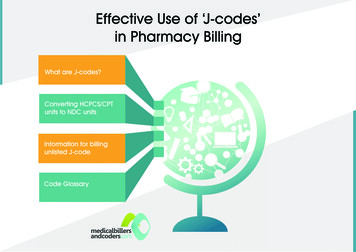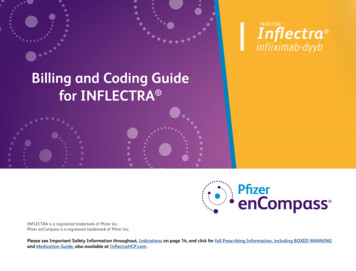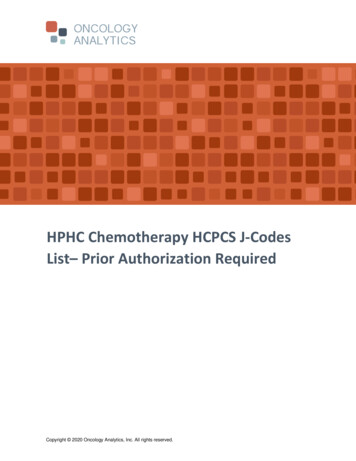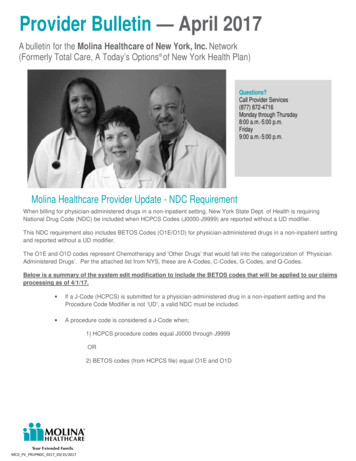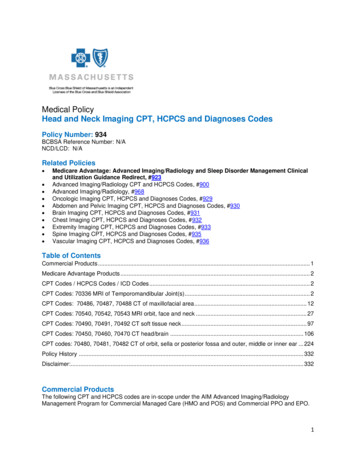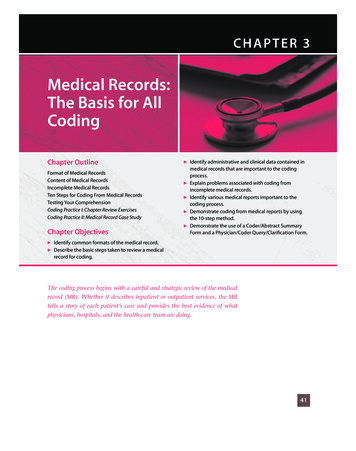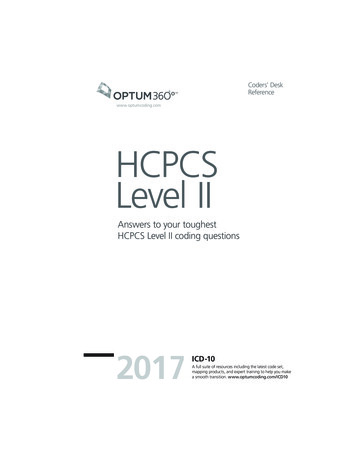
Transcription
CDRH.book.2.fm Page 1 Friday, December 4, 2015 11:34 AMCoders’ DeskReferencewww.optumcoding.comHCPCSLevel IIAnswers to your toughestHCPCS Level II coding questions2017ICD-10A full suite of resources including the latest code set,mapping products, and expert training to help you makea smooth transition. www.optumcoding.com/ICD10
CDRH.book.2.fm Page i Friday, December 4, 2015 11:34 AMContentsDuplicate Claim Denials . 43The Purchase and Rental of DMEPOSItems .44DMEPOS Repairs and Maintenance . 45Introduction to HCPCS .iiiCoding Systems . iiiUsing Modifiers .1Ambulance Modifiers . 1HCPCS Level II Modifiers . 1Documentation Standards .13Medical Records Documentation forProviders .13General DME Documentation Standards .13Documentation for DMEPOS Suppliers .14Durable Medical Equipment, Prosthetics,Orthotics, and Supplies (DMEPOS) .17The DMEPOS Industry .17Special Federal and Third-Party PayerDefinitions .17Accreditation .19Durable Medical Equipment, Prosthetics,Orthotics, and Supplies and the Office ofInspector General .25General Billing, Claims, and Coverage Issues .29ASC X12N 837 Claim Formats .29DMEPOS for Hospital Inpatients .29Provider Taxonomy Codes .29Medical Necessity and DMEPOS .29Certificates of Medical Necessity .30DMEPOS Prior Authorizations/Advance Determination ofMedicare Coverage .34Local Coverage Determination (LCD) .35Medicare Program Requirements .35Mandatory Provider and Supplier ClaimSubmission .36Electronic DMEPOS Claims .36Electronic Submission of MedicalDocumentation .37Signature on File (SOF) Requirements .37Beneficiary Right to Itemized Statements .38Medicare Secondary Payer Policiesand DMEPOS .38Medicare Coverage for Beneficiaries in State orLocal Custody Under a PenalAuthority .39DMEPOS Claims Jurisdictions .40Medicare and DME MAC Claims Denials .41The Advance Beneficiary Notice (ABN)of Noncoverage .41Equipment and Service Upgrades .42Appeals, Grievances, and Sanctions . 49Medicare Appeals . 49LCD (Local Coverage Determination)Appeals (Reconsiderations) . 51Third-Party Payer Appeals . 51Third-Party Payer Sanctions .53Fraud, Abuse, and Compliance . 55Introduction .55Definitions of Fraud and Abuse . 55Definition of Compliance . 56Criminal and Civil Statutes . 56Federal Fraud and Abuse InvestigativePrograms .57Medicare Integrity Program . 58Recovery Audit Contractors . 59Physician Order Fraud .60Realigning Internal Operations .61The OIG’s Compliance Program Guidancefor the DMEPOS Industry .62Lines of Communication . 62Anti-Kickback and Self-Referral Concerns . 62Auditing and Monitoring .63Whistleblowers . 63Billing Companies: OIG Guidelines . 64Fraud and Abuse and Medicare Patients .65The Health Insurance Portability andAccountability Act (HIPAA) of 1996 . 67HIPAA Administrative Simplification . 67Reimbursement Guidelines . 71DMEPOS Utilization and Authorization . 71PPS and Consolidated Billing . 71Financial Management Guidelines .74Financial Formulas . 74Conducting Cost and ReimbursementAnalyses . 74DMEPOS Cost Study .74Medicare Guidelines for Selected Topics . 77ESRD Equipment, Supplies, and Drugs andBiologicals . 77Diabetic Supplies and Services .78Dressings .81Drugs, Biologicals, andRadiopharmaceuticals . 82Enteral Nutrition .85 2016 Optum360, LLCCPT only 2015 American Medical Association. All Rights Reserved.i
CDRH.book.2.fm Page ii Friday, December 4, 2015 11:34 AMCoders’ Desk Reference for HCPCSHospital Beds .86Infusion Pumps, External; Equipmentand Supplies .88Intravenous Immune Globulin .92Lens .93Ostomy Devices and Supplies .93Oxygen (O2) and O2 Equipment .94Parenteral Nutrition .96Pressure Reducing Support Surfaces:Groups I, II, and III .98Prosthetic and Orthotic Devices . 101Off-the-Shelf Orthotics . 102iiTranscutaneous Electrical NerveStimulation .106Urological Supplies .108Wheelchairs and Power Mobility Devices .110Medicare Noncovered Codes . 113Glossary . 117HCPCS Lay Descriptions . 137 2016 Optum360, LLCCPT only 2015 American Medical Association. All Rights Reserved.
CDRH.book.2.fm Page 1 Friday, December 4, 2015 11:34 AMThe HCPCS Level II codes are alphanumeric codesdeveloped by CMS as a complementary codingsystem to the AMA’s CPT codes. HCPCS Level II codesdescribe procedures, services, and supplies not foundin the CPT manual.Similar to the CPT coding system, HCPCS Level II codescontain modifiers that serve to further define servicesand items without changing the basic meaning of theHCPCS Level II code with which they are reported.It is important to note that HCPCS Level II modifiersmay be used in conjunction with CPT codes, such as69436 LT Tympanostomy (requiring insertion ofventilating tube), general anesthesia, left ear.Likewise, CPT modifiers can be used when reportingHCPCS Level II codes, such as L4396 50 Anklecontracture splint, bilateral (this scenario can also bereported with modifiers RT and LT, depending on thethird-party payer’s protocol). In some cases, a reportmay be required to accompany the claim to supportthe need for a particular modifier’s use, especially incases when the presence of a modifier causessuspension of the claim for manual review andpricing.Ambulance ModifiersFor ambulance services modifiers, there are singlealpha characters with distinct definitions that arepaired together to form a two-character modifier. Thefirst character indicates the origination of the patient(e.g., private residence, physician office, etc.) and thesecond character indicates the destination of thepatient (e.g., hospital, skilled nursing facility, etc.).When reporting ambulance services, the name of thehospital or facility should be included on the claim. Ifreporting the scene of an accident or acute event(character S) as the origin of the patient, a writtendescription of the actual location of the scene or eventmust be included with the claim.Ambulance modifiers must be reported as twocharacters. For example, an ambulance transport froman accident scene to an acute care hospital wouldhave modifier SH appended to the ambulance HCPCScode.Ambulance Modifier ListingDEGHDiagnostic or therapeutic site other than “P” or“H” when these are used as origin codesResidential domiciliary, custodial facility (otherthan 1819 facility)Hospital-based ESRD facilityHospitalIJNPRSXSite of transfer (for example, airport orhelicopter pad) between modes of ambulancetransportFreestanding ESRD facilitySkilled nursing facilityPhysician’s officeResidenceScene of accident or acute eventIntermediate stop at physician’s office on way tohospital (destination code only). Note: ModifierX can only be used as a designation code in thesecond position of a modifierHCPCS Level II ModifiersAlphabetical ListingA1A2A3A4A5A6A7A8A9AAADAEAFAGAHAI 2016 Optum360, LLCCPT only 2015 American Medical Association. All Rights Reserved.Dressing for one woundDressing for two woundsDressing for three woundsDressing for four woundsDressing for five woundsDressing for six woundsDressing for seven woundsDressing for eight woundsDressing for nine or more woundsAnesthesia performed personally byanesthesiologist CPT codes approved for use with modifierAA are 00100–01999. If an anesthetist assists the physician in thecare of a single patient, the service isconsidered personally performed by thephysician. The anesthesiologist shouldreport this service with modifier AA and theappropriate CPT code from series00100–01999. Modifier AA affects Medicare payment.Medical supervision by a physician; more thanfour concurrent anesthesia procedures Modifier AD affects Medicare payment as adistinct fee schedule amount exists.Registered dietitianSpecialty physicianPrimary physicianClinical psychologistPrincipal physician of record1Using ModifiersUsing Modifiers
CDRH.book.2.fm Page 29 Friday, December 4, 2015 11:34 AMGeneral Billing, Claims, andCoverage IssuesASC X12N 837 Claim FormatsPhysicians and suppliers must submit all electronicMedicare Claims data to Medicare using the ASC X12N837 claim format. The current version of the standardsis 005010X0223A2 for institutional claims,005010X0222A for professional claims,005010X224A2 for dental claims, and the NationalCouncil for Prescription Drug Programs [NCPDP]version D.0. for pharmacy transactions.Providers can keep up to date with the version 5010schedule by accessing the CMS website links index.html?redirect /Versions5010andD0/.DMEPOS for Hospital InpatientsMedicare does not allow separate payment fordurable medical equipment, prosthetics, orthotics,and supplies (DMEPOS) when a patient is in a coveredinpatient stay. These claims were related to DME datesof service greater than two days prior to Part Adischarge date or Part A discharge status was not tohome. Effective July 1, 2013, the DME claim will berejected or, if paid, the contractor will institutepayment recovery when all of the followingconditions are met:There is a covered Medicare Part A inpatientclaim with a TOB of 0111 The DME and the inpatient claims are for thesame beneficiary HICN The DME claim has a line item within the HCPCSLevel II category 03 for orthotics and/orprosthesis The from date of service (DOS) of the durablemedical equipment item is within the Part Aadmit and discharge dates The from DOS of the durable medical equipmentline items is greater than two days prior to thebeneficiary’s Part A inpatient discharge date If the from DOS of the DME line items is withinthe beneficiary’s Part A inpatient admission anddischarge date and the patient discharge status(FL 17) is NOT equal to 01 Discharged to home orself-care (routine discharge)The CMS Recovery Audit Contractor (RAC) Program,which is responsible for identifying and correctingimproper payments in the Medicare fee-for-servicepayment process, identified this issue. The contractoridentified DMEPOS claims for patients who receivedDMEPOS items while in an inpatient stay in a hospital.Since Medicare does not allow separate payments forDMEPOS for the patient during a covered inpatienthospital stay, these payments associated with theseclaims are considered overpayments.Medicare will cover DME that falls within an inpatientstay when the claim is for maintenance and servicingof capped rental items and when the claim containsmodifier MS. (Medicare Claims Processing Manual, Pub.100-4, Chap. 20, Sec. 210)Provider Taxonomy CodesProvider taxonomy codes are 10-character,alphanumeric codes that identify the specialty of theprovider. HIPAA regulations require the use of thesetaxonomy codes. The taxonomy code must be used toidentify the provider or supplier’s specialty when thetaxonomy code affects claim adjudication.The current list of provider taxonomy codes isavailable from http://www.wpc-edi.com. RegionalDME MACs may be able to provide a current list.Medical Necessity and DMEPOSFor DMEPOS items or services to be billed to aMedicare contractor, the physician or provider musthave documentation demonstrating the medicalnecessity of the item. This information must be a partof the patient’s medical record. For suppliers ofDMEPOS items, an official order signed and dated bythe ordering provider must be obtained. The ordermust detail the following: The patient’s identifying information A description of the DMEPOS item The reason for the DMEPOS prescription, whichcan take the form of the ICD-10-CM code and/ordiagnosis narrative information The start date of the order must be clearlyspecified 2016 Optum360, LLCCPT only 2015 American Medical Association. All Rights Reserved.29General Billing (Medicare Claims Processing Manual, Pub. 100-4, Chap.20, Sec. 01, 10, 30, 30.6, 110.2, 110.3.3, 130.5, 160.1,160.2, 170, 210)
CDRH.book.2.fm Page 231 Friday, December 4, 2015 11:34 AMHCPCS Lay DescriptionsE0434-E0435E0424 Stationary compressed gaseous oxygensystem, rental; includes container,contents, regulator, flowmeter,humidifier, nebulizer, cannula or mask,and tubingE0425 Stationary compressed gas system,purchase; includes regulator, flowmeter,humidifier, nebulizer, cannula or mask,and tubingE0434 Portable liquid oxygen system, rental;includes portable container, supplyreservoir, humidifier, flowmeter, refilladaptor, contents gauge, cannula ormask, and tubingE0435 Portable liquid oxygen system, purchase;includes portable container, supplyreservoir, flowmeter, humidifier, contentsgauge, cannula or mask, tubing and refilladaptorLay DescriptionOxygen is stored in several manners, one of which isas a compressed gas. The compression mandates useof heavy, reinforced tanks that constitute a stationarysystem. A regulator fits on top of the tank and is anadjustment device to control the flow of oxygen at theprescribed rate. A flow meter conserves the release ofoxygen by turning on and shutting off the regulatedflow as the patient inhales and exhales. A nasalcannula is common for lower delivery rates. A maskand/or nebulizer may be used for higher delivery ratesand a catheter directly to the trachea is sometimesrequired. An in-line humidification system may alsobe used to modulate effects of higher flows.E0430-E0431E0430 Portable gaseous oxygen system,purchase; includes regulator, flowmeter,humidifier, cannula or mask, and tubingE0431 Portable gaseous oxygen system, rental;includes portable container, regulator,flowmeter, humidifier, cannula or mask,and tubingLay DescriptionPortable gaseous oxygen systems are typicallylightweight aluminum tanks (usually designated as Ctanks) containing pressurized gaseous oxygen. Thepressurized systems are stable and the product storeswell up to time of use. In some instances, these unitsmay be refilled from large stationary gas oxygentanks. These systems are generally designed foremergency or occasional use. These codes include alldelivery hardware associated with use of the system(regulator, flowmeter, mask, tubing, etc.).E0433E0433 Portable liquid oxygen system, rental;home liquefier used to fill portable liquidoxygen containers, includes portablecontainers, regulator, flowmeter,humidifier, cannula or mask and tubing,with or without supply reservoir andcontents gaugeLay DescriptionA portable liquid oxygen system is a cooling devicethat converts air into liquid oxygen by cooling it to-279 degrees Fahrenheit. The device is designed tostore the liquid oxygen and allow patients to refilltheir portable oxygen containers. 2016 Optum360, LLCLay DescriptionPortable liquid oxygen tanks are insulatedthermos-like units that store comparatively largequantities of oxygen at lower pressures than gaseoussystems. Several hundred times more oxygen can bestored as liquid in the same amount of space than inits gaseous form. The liquid oxygen is stored cold andconverted to gas as it is warmed through anapparatus at the reservoir. Portable units typicallyweigh eight to 10 pounds and are designed to berefillable from larger, stationary tanks. Portable liquidsystems are prone to evaporation loss and the productshould be used shortly after decanting. These codesinclude all oxygen delivery hardware associated withuse of the system (regulator, flowmeter, mask, tubing,etc.), including refill adapters.E0439-E0440E0439 Stationary liquid oxygen system, rental;includes container, contents, regulator,flowmeter, humidifier, nebulizer, cannulaor mask, & tubingE0440 Stationary liquid oxygen system,purchase; includes use of reservoir,contents indicator, regulator, flowmeter,humidifier, nebulizer, cannula or mask,and tubingLay DescriptionStationary liquid oxygen systems are insulatedthermos-like units that store comparatively largequantities of oxygen at lower pressures than gaseoussystems. (Several hundred times more oxygen can bestored as liquid in the same amount of space than inits gaseous form.) The liquid oxygen is stored cold andconverted to gas as it is warmed through anapparatus at the reservoir. Stationary units may weigh75 to 100 pounds and can contain enough liquidoxygen to last patients up to eight days, dependingon level of use. In many instances, the stationarysystem is also used to decant liquid oxygen intosmaller, portable systems. These codes include alloxygen delivery hardware associated with use of thestationary system (regulator, flowmeter, mask, tubing,etc.).231EE0424-E0425
CDRH.book.2.fm Page 362 Friday, December 4, 2015 11:34 AMCoders’ Desk Reference for HCPCSJ2430J2430 Injection, pamidronate disodium,per 30 mgLay DescriptionPamidronate disodium is used to treat hypercalcemiafrom cancer, Paget's disease, osteolytic bonemetastases of breast cancer, and osteolytic bonelesions of multiple myeloma. Pamidronate disodiumacts as an antihypercalcemic, inhibiting the resorptionof bone and blocking the formation of matureosteoclasts. Cardiovascular side effects of atrialfibrillation and tachycardia may occur, withhypertension a common side-effect as well as fatigue,abdominal pain, nausea, constipation, anorexia, andanemia.J2440J2440 Injection, papaverine HCl, up to 60 mgLay DescriptionPapaverine hydrochloride is an alkaloid extractedfrom opium or synthetically produced. The drugrelaxes smooth muscles, especially when is has beencontracted in spasm. The drug directly relaxes thecardiac and vascular systems, bronchial muscles, andgastrointestinal, biliary, and urinary tracts. Its effect onthe vascular system includes coronary, cerebral,peripheral, and pulmonary arteries. It has minimaleffect on the central nervous system, though largedoses can cause some sedation. Papaverinehydrochloride is indicated in erectile dysfunction andvarious conditions where spasms occur, such asvascular spasm associated with acute myocardialinfarction, angina pectoris, peripheral embolism,pulmonary embolism, and visceral spasms such asgastrointestinal colic and ureteral or biliary spasms. Itmay also be useful in peripheral vascular disease withvasospastic elements and certain cerebralangiospasms.J2460JJ2460 Injection, oxytetracycline HCl, up to50 mgLay DescriptionOxytetracycline hydrochloride is a broad-spectrumantibiotic of the tetracycline group produced by thebacterium Streptomyces rimosus. Its mechanism ofaction is not known, but it is thought to inhibit proteinsynthesis. Oxytetracycline is effective against a widerange of both gram-positive and gram-negativeorganisms. Susceptibility studies should beperformed prior to the administration of this drug.Cross resistance among drugs in the tetracyclinefamily is common. Susceptible organisms includerickettsiae, Mycoplasma pneumoniae, Borreliarecurrentis, Escherichia coli, Enterobacter aerogenes,Pseudomonas aeruginosa, Haemophilus aegyptius,Shigella species, Mima species, Herellea species,Haemophilus influenzae, Klebsiella species, Diplococcuspneumoniae, Staphylococcus aureus, Neisseria362gonorrhoeae, Treponema pallidum, Treponemapertenue, Listeria monocytogenes, Clostridium species,Bacillus anthracis, Fusobacterium fusiforme, andActinomyces species. It may also be used incombination with amebicides to treat acute intestinalamebiasis.J2469J2469 Injection, palonosetron HCl, 25 mcgLay DescriptionPalonosetron hydrochloride is a chemical compoundthat is a selective blocker of serotonin 5-HT3receptors. Serotonin 5-HT3 receptors are present onthe vagal nerve and at sensory nerve endings.Cytotoxic chemotherapy appears to trigger therelease of serotonin in the small intestine, which maytrigger the 5-HT3 receptors and initiate the vomitingreflex. It is indicated to prevent and treat nausea andvomiting associated with chemotherapy.Palonosetron hydrochloride is administered byintravenous injection. The recommended dosage ofthe injectable form is 25 mcg.J2501J2501 Injection, paricalcitol, 1 mcgLay DescriptionParicalcitol is a synthetic analogue of calcitriol,vitamin D. Vitamins are organic compounds necessaryto the metabolic functioning of the body. Vitamin D isa fat-soluble vitamin that is a group of relatedcompounds commonly called calciferol. Two commonforms are cholecalciferol and ergocalciferol. Vitamin Dis a steroid hormone precursor and helps to maintaincalcium and phosphorus levels throughout the body.Human skin can produce vitamin D when exposed tosunlight, specifically UVB. Secondaryhyperparathyroidism is characterized by an increase inparathyroid hormone to compensate for inadequatelevels of active vitamin D hormone. Paricalcitol isindicated for the prevention and treatment ofhyperparathyroidism secondary to chronic renalfailure. The injectable form is administered byintravenous injection and is primarily used when thepatient has stage 5 chronic renal disease.J2502J2502 Injection, pasireotide long acting, 1 mgLay DescriptionPasireotide is a somatostatin analog. It is utilized forthe treatment of acromegaly in patients who have anunsatisfactory response to surgery or where surgicalintervention is not plausible. It is administered viaintramuscular injection with an initial dose of 40 mgand repeated every four weeks (28 days). Thesubsequent doses should be adjusted based ontreatment response and tolerance. 2016 Optum360, LLC
CDRH.book.2.fm Page 486 Friday, December 4, 2015 11:34 AMCoders’ Desk Reference for HCPCSLL6200-L6205L6200 Elbow disarticulation, molded socket,outside locking hinge, forearmL6205 Elbow disarticulation, molded socketwith expandable interface, outsidelocking hinges, forearmLay DescriptionThese codes are used to report an exoskeletalprosthesis for an elbow disarticulation or long,transhumeral amputation. It includes a custom-fittedsocket fabricated from a model of a patient and acustom-fabricated forearm using an outside lockinghinge and a friction wrist unit. An expandableinterface allows for differences in residual limb size.L6250L6250 Above elbow, molded double wall socket,internal locking elbow, forearmprostheses designed to perform work. A passivefunctional prosthesis offers very realistic cosmeticsand can perform limited function.L6320L6320 Shoulder disarticulation, passiverestoration (shoulder cap only)Lay DescriptionThe code refers to an upper extremity restoration(cap) prosthesis for the shoulder of a shoulderdisarticulation amputation. It includes a custom-fittedsocket fabricated from a model of the patient withspecial modifications to restore shoulder shape andprotect the amputation area. A passive system isprimarily cosmetic but also functions as a stabilizer. Apassive system is fabricated if the patient does nothave enough strength or movement to control aprosthesis or wears a prosthesis only because ofcosmetic concerns.Lay DescriptionA transhumeral prothesis is an artificial limb thatreplaces an arm missing above the elbow. This coderefers to a transhumeral amputation that includes acustom-fitted double wall socket fabricated from amodel of the patient, a custom-fabricated forearmusing an internal locking elbow, and a friction wristunit.L6300L6300 Shoulder disarticulation, molded socket,shoulder bulkhead, humeral section,internal locking elbow, forearmLay DescriptionThis code refers to an exosketetal prosthesis for ashoulder disarticulation amputation. It includes acustom-fitted socket fabricated from a model of apatient, a custom-fabricated humeral section, and aforearm using a shoulder bulkhead, an internallocking elbow, and friction wrist unit. Exoskeletalprostheses have a hard outer shell, which can usuallywithstand considerable force. Exoskeletal designs areusually preferred for prostheses designed to performwork.L6310L6310 Shoulder disarticulation, passiverestoration (complete prosthesis)Lay DescriptionThis code refers to an exoskeletal passive prosthesisfor a shoulder disarticulation amputation. It includes acustom-fitted socket fabricated from a model of thepatient, a custom-fabricated humeral section andforearm using a passive elbow, a passive terminaldevice (the most distal part of a prosthesis thatsubstitutes for the hand; it may be a prosthetic hand, ahook, or another device), and a friction wrist unit andsuspension. Exoskeletal prostheses have a hard outershell, which can usually withstand considerable force.Exoskeletal designs are usually preferred for486L6350L6350 Interscapular thoracic, molded socket,shoulder bulkhead, humeral section,internal locking elbow, forearmLay DescriptionAn interscapular-thoracic amputation is the surgicalseparation of the humerus (upper arm bone), scapula(shoulder blade), and a portion of the clavicle (collarbone) from the body. In this procedure the entireshoulder and arm are removed. This code refers to anexoskeletal prosthesis for an interscapular thoracicamputation. It includes a custom-fitted socketfabricated from a model of the patient, acustom-fabricated humeral section, forearm utilizinga shoulder bulkhead, an internal locking elbow, and afriction wrist unit.L6360L6360 Interscapular thoracic, passiverestoration (complete prosthesis)Lay DescriptionAn interscapular-thoracic amputation is the surgicalseparation of the humerus (upper arm bone), scapula(shoulder blade), and a portion of the clavicle (collarbone) from the body. In this procedure, the entireshoulder and arm are removed. This code refers to thecomplete passive restoration. A passive system isprimarily cosmetic but also functions as a stabilizer. Apassive system is fabricated if the patient does nothave enough strength or movement to control aprosthesis or wears a prosthesis only because ofcosmetic concerns.L6370L6370 Interscapular thoracic, passiverestoration (shoulder cap only)Lay DescriptionAn interscapular-thoracic amputation is the surgicalseparation of the humerus (upper arm bone), scapula 2016 Optum360, LLC
may be used in conjunction with CPT codes, such as 69436 LT Tympanostomy (requiring insertion of ventilating tube), general anesthesia, left ear. Likewise, CPT modifiers can be used when reporting HCPCS Level II codes, such as L4396 50 Ankle contracture splint, bilateral (this scenario can al

